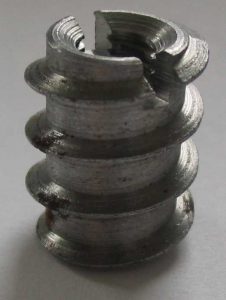
Not all nuts feature a traditional hexagonal shape. While hexagonal nuts are popular because they are easier to turn — and therefore install — than other shapes, but that doesn’t mean all nuts are hexagonal. Insert nuts, for example, feature a cylindrical shape with exterior threading. As shown in the image to the left, they share little or no resemblance to hexagonal nuts. So, what is an insert nut exactly, and how do they work?
Overview of Insert Nuts
An insert nut is a type of fastener with a hollow interior that’s used to support a bolt. They feature both internal, as well as external, threading. The exterior threading allows the insert nut to be “inserted” into an object or workpiece, whereas the internal threading allows a bolt to be driven into the insert nut.
How Insert Nuts Work
Insert nuts work in a similar way as wall anchors by creating a support system for a separate fastener, such as a bolt. Rather than driving a bolt directly into an object, an insert nut is inserted into the object. The bolt is then driven into the insert nut.
The purpose of insert nuts is to create a stable and secure hold with the bolt. In certain objects, particularly those made of wood, bolts may gradually pull out over time. Insert nuts prevent this from happening by gripping into the object. The exterior threading will bite into the object during insertion. Once in place, a bolt can then be driven into the insert nut’s interior threading.
Screw-In vs Hammer-In Insert Nuts
There are two primary types of insert nuts: screw-in and hammer-in. Screw-in insert nuts live up to their namesake by being “screwed” into an object, whereas hammer-in insert nuts are hammered” into an object. Screw-in insert nuts are often preferred because they are less likely to damage the object in which they are inserted. Nonetheless, both screw-in and hammer-in insert nuts can be used to support a bolt. The only difference between them is that they are installed in different ways.
In Conclusion
Screw-in nuts are commonly used in the construction of wooden furniture. They feature internal and external threading, the former of which supports a bolt. Insert nuts are driven or inserted into an object, at which point a bolt is driven into their hollow, threaded interior.
